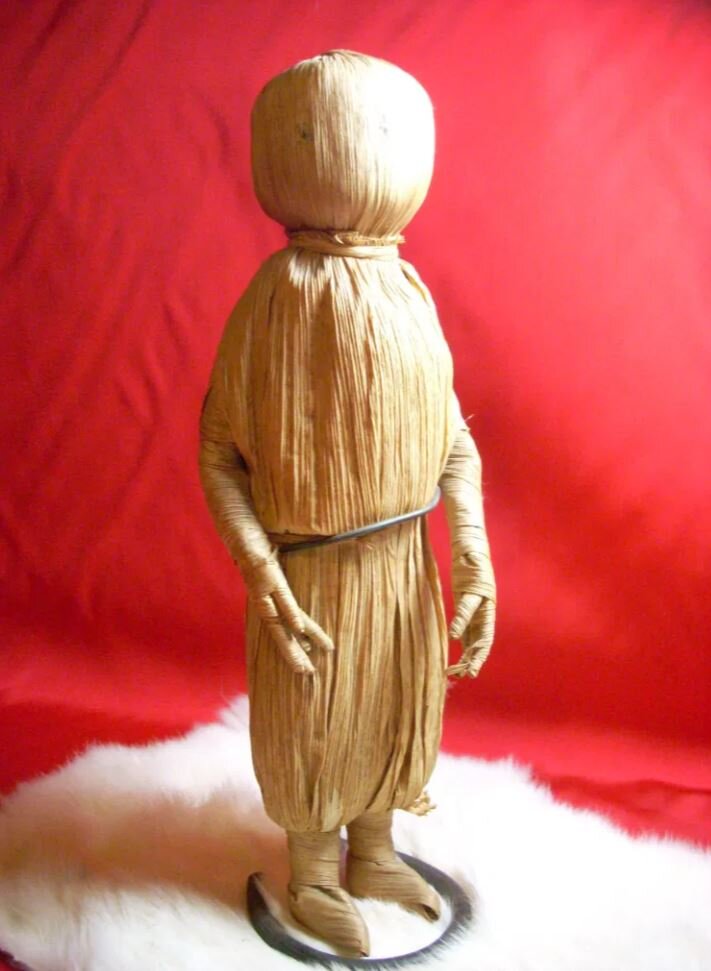Harvest Corn Dollies
Corn dolly from The Museum of Witchcraft & Magic
The first thing you may notice about the “Corn Dolly” on the right, dear readers, is that it doesn’t appear to be made from corn. Good eye.
“Corn” was an umbrella term used to refer to any kind of grain — such as wheat, rye, oats — in parts of Northern Europe.
Making corn dollies is a traditional harvest time activity. Constructed form the last bit of corn to be harvested, the spirit of the corn was believed to inhabit the dolly. In the winter, the dolly resided indoors; in the spring, the spirit was returned to the earth — either by ploughing it back into the ground during the first planting or burning the dolly and spreading its ashes in the field.
The harvest rituals associated with the Corn Mother and Corn Maiden are described by James George Frazer (1922):
“In the neighborhood of Danzig the person who cuts the last ears of corn makes them into a doll, which is called the Corn-mother or the Old Woman and is brought home on the last wagon. In some parts of Holstein the last sheaf is dressed in women's clothes and called the Corn-mother. It is carried home on the last wagon, and then thoroughly drenched with water. The drenching with water is doubtless a rain-charm. In the district of Bruck in Styria the last sheaf, called the Corn-mother, is made up into the shape of a woman by the oldest married woman in the village, of an age from 50 to 55 years. The finest ears are plucked out of it and made into a wreath, which, twined with flowers, is carried on her head by the prettiest girl of the village to the farmer or squire, while the Corn-mother is laid down in the barn to keep off the mice. In other villages of the same district the Corn-mother, at the close of harvest, is carried by two lads at the top of a pole. They march behind the girl who wears the wreath to the squire's house, and while he receives the wreath and hangs it up in the hall, the Corn-mother is placed on the top of a pile of wood, where she is the centre of the harvest supper and dance.”— The Golden Bough, chapter 45
If you want to take a deep dive on these dollies, The House recommends this piece by Museum Crush or this piece from Sabbat Box.
The type of corn dolly shown below and at right is known as a Kern Babby (see 'The Origins of Popular Superstitions and Customs' by T. Sharper Knowlson (1910)). “These magical figures were made around harvest time. Sometimes they would be carried in procession or sat at the head of the table to represent the spirit of the harvest. Often they would then be sat on the last pew in the local church (sometimes with an apple in the pocket). At the end of a year they would be burnt and their ashes scattered over the fields to insure a good new harvest.” — The Museum of Witchcraft and Magic
As noted above, corn dollies were typically crafted out of wheat, rye, barley, and oats in Great Britain. In Ireland, they were made out of rush, and in Southern France, palm leaves. And of course, indigenous peoples in the Americas have made dolls from the husks of actual corn for thousands of years. Each tribe has a different story of their doll’s creation.
Corn husk doll, Seneca Indians, Eastern Woodlands Area. Yale Peabody Museum of Natural History
Even though this practice dates back hundreds of years, there are modern practitioners who are keeping it alive -- such as MayQueen Crafts (Instagram: mayqueencrafts) and Corn on the Mob (Instagram: corn_onthemob).
Representations of the Ancient Roman goddess Ceres are said to have been made out of an entire sheath of wheat. Ceres is the goddess of growing plants (particularly cereals) and of motherly love.








